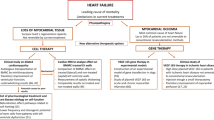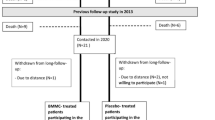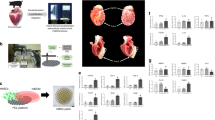Abstract
Intramyocardial delivery of genes and cells derived from bone marrow has been evaluated in several small studies of 'no-option' symptomatic patients with chronic ischemic coronary artery disease. Clinical experience with intramyocardial gene delivery is limited to genes encoding isoforms of vascular endothelial cell growth factor. In the largest study (Euroinject One), 80 patients were randomized to receive a plasmid encoding vascular endothelial cell growth factor 165 or placebo. The results of this study suggested no beneficial therapeutic effect of this strategy. The experience with stem cells is limited to use of autologous, nonexpanded, nonmanipulated bone-marrow-derived cells; thus, the number of injected stem cells reflects their natural proportion within the bone marrow. The results of these preliminary studies suggest this approach is feasible and has a high safety profile. Although no conclusion can yet be made regarding efficacy, the improved myocardial perfusion in all four studies described in this Review is encouraging. Data from assessments of individual patients, however, suggests a wide variability in response, underscoring the need for further bench and clinical investigations.
Key Points
-
Catheter-based transendocardial cell and gene delivery for therapeutic angiogenesis has so far been studied in only a small number of patients
-
Studies have so far involved only autologous, nonexpanded, nonmanipulated bone-marrow-derived cells and gene encoding vascular endothelial growth factor
-
Nonfluoroscopic electromechanical mapping-guided myocardial navigation can help locate the most vulnerable ischemic territory
-
Although some complications have been reported, overall, transendocardial injection seems to be safe
-
No predictors of a favorable response to therapy have yet been clearly identified
This is a preview of subscription content, access via your institution
Access options
Subscribe to this journal
Receive 12 print issues and online access
$209.00 per year
only $17.42 per issue
Buy this article
- Purchase on Springer Link
- Instant access to full article PDF
Prices may be subject to local taxes which are calculated during checkout
Similar content being viewed by others
References
Thom T et al. American Heart Association Statistics Committee and Stroke Statistics Subcommittee. (2006) Heart disease and stroke statistics—2006 update: a report from the American Heart Association Statistics Committee and Stroke Statistics Subcommittee. Circulation 113: e85–151
Mukherjee D et al. (1999) Direct myocardial revascularization and angiogenesis—how many patients might be eligible? Am J Cardiol 84: 598–600, A8
Henry TD et al. for the VIVA Investigators* (2003) The VIVA Trial: Vascular Endothelial Growth Factor in Ischemia for Vascular Angiogenesis. Circulation 107: 1359–1365
Simons M et al. (2002) Pharmacological treatment of coronary artery disease with recombinant fibroblast growth factor-2: double-blind, randomized, controlled clinical trial. Circulation 105: 788–793
Lunde K et al. (2006) Intracoronary injection of mononuclear bone marrow cells in acute myocardial infarction. N Engl J Med 355: 1199–1209
Assmus B et al. (2006) Transcoronary transplantation of progenitor cells after myocardial infarction. N Engl J Med 355: 1222–1232
Losordo DW et al. (2002) Phase 1/2 placebo-controlled, double-blind, dose-escalating trial of myocardial vascular endothelial growth factor 2 gene transfer by catheter delivery in patients with chronic myocardial ischemia. Circulation 105: 2012–2018
Kastrup J et al. Euroinject One Group (2005) Direct intramyocardial plasmid vascular endothelial growth factor-A165 gene therapy in patients with stable severe angina pectoris. A randomized double-blind placebo-controlled study: the Euroinject One trial. J Am Coll Cardiol 45: 982–988
Fuchs S et al. (2006) A randomized, double-blind, placebo-controlled, multicenter, pilot study of the safety and feasibility of catheter-based intramyocardial injection of AdVEGF121 in patients with refractory advanced coronary artery disease. Catheter Cardiovasc Interv 68: 372–378
Perin EC et al. (2004) Improved exercise capacity and ischemia 6 and 12 months after transendocardial injection of autologous bone marrow mononuclear cells for ischemic cardiomyopathy. Circulation 110 (Suppl 1): II213–218
Tse H-F et al. (2003) Angiogenesis in ischaemic myocardium by intramyocardial autologous bone marrow mononuclear cell implantation. Lancet 361: 47–49
Fuchs S et al. (2006) Safety and feasibility of transendocardial autologous bone marrow cell transplantation in patients with advanced heart disease. Am J Cardiol 97: 823–829
Tse H-F et al. (2006) Prospective randomized trial of direct endomyocardial implantation of bone marrow cells for therapeutic angiogenesis in coronary artery disease. Presented at the 55th Annual Scientific Session of the American College of Cardiology: 2006 11–14 March; Atlanta, GA
Siminiak T et al. (2005) Percutaneous trans-coronary-venous transplantation of autologous skeletal myoblasts in the treatment of post-infarction myocardial contractility impairment: the POZNAN trial. Eur Heart J 26: 1188–1195
Gepstein L et al. (1997) A novel method for nonfluoroscopic catheter-based electroanatomical mapping of the heart. In vitro and in vivo accuracy results. Circulation 95: 1611–1622
Fuchs S et al. (2001) Comparison of endocardial electromechanical mapping with radionuclide perfusion imaging to assess myocardial viability and severity of myocardial ischemia in angina pectoris. Am J Cardiol 87: 874–880
Kornowski R et al. (2001) Catheter-based electromechanical mapping to assess regional myocardial function: a comparative analysis with transthoracic echocardiography. Catheter Cardiovasc Interv 52: 342–347
Wiggers H et al. (2003) Electromechanical mapping versus positron emission tomography and single photon emission computed tomography for the detection of myocardial viability in patients with ischemic cardiomyopathy. J Am Coll Cardiol 41: 843–848
Dvorak HF (2005) Angiogenesis: update 2005. J Thromb Haemost 3: 1835–1842
Byrne AM et al. (2005) Angiogenic and cell survival functions of vascular endothelial growth factor (VEGF). J Cell Mol Med 9: 777–794
Galiano RD et al. (2004) Topical vascular endothelial growth factor accelerates diabetic wound healing through increased angiogenesis and by mobilizing and recruiting bone marrow-derived cells. Am J Pathol 164: 1935–1947
Grines C et al. (2003) Angiogenic gene therapy with adenovirus 5 fibroblast growth factor-4 (Ad5FGF-4): a new option for the treatment of coronary artery disease. Am J Cardiol 92: 24N–31N
Bartunek J et al. (2005) Intracoronary injection of CD133-positive enriched bone marrow progenitor cells promotes cardiac recovery after recent myocardial infarction: feasibility and safety. Circulation 112 (Suppl): I178–183
Nakagami H et al. (2006) Adipose tissue-derived stromal cells as a novel option for regenerative cell therapy. J Atheroscler Thromb 13: 77–81
Zhang WJ et al. (2006) Morphologic, phenotypic and functional characteristics of endothelial cells derived from human hepatic cavernous hemangioma. J Vasc Res 43: 522–532
Nishishita T et al. (2004) A potential pro-angiogenic cell therapy with human placenta-derived mesenchymal cells. Biochem Biophys Res Commun 325: 24–31
McMahon JM et al. (2006) Gene transfer into rat mesenchymal stem cells: a comparative study of viral and nonviral vectors. Stem Cells Dev 15: 87–96
Hou D et al. (2005) Radiolabeled cell distribution after intramyocardial, intracoronary, and interstitial retrograde coronary venous delivery: implications for current clinical trials. Circulation 112: 150–156
Author information
Authors and Affiliations
Corresponding author
Ethics declarations
Competing interests
Shmuel Fuchs receives consultation fees from Biologics Delivery Systems Group and Cordis Corporation. Alexander Battler and Ran Kornowski declared no competing interests.
Rights and permissions
About this article
Cite this article
Fuchs, S., Battler, A. & Kornowski, R. Catheter-based stem cell and gene therapy for refractory myocardial ischemia. Nat Rev Cardiol 4 (Suppl 1), S89–S95 (2007). https://doi.org/10.1038/ncpcardio0762
Received:
Accepted:
Issue Date:
DOI: https://doi.org/10.1038/ncpcardio0762
This article is cited by
-
Biogerontology research in Israel
Biogerontology (2011)
-
Delivery of Gene and Cellular Therapies for Heart Disease
Journal of Cardiovascular Translational Research (2010)
-
Percutaneous Transendocardial Delivery of Self-complementary Adeno-associated Virus 6 Achieves Global Cardiac Gene Transfer in Canines
Molecular Therapy (2008)



